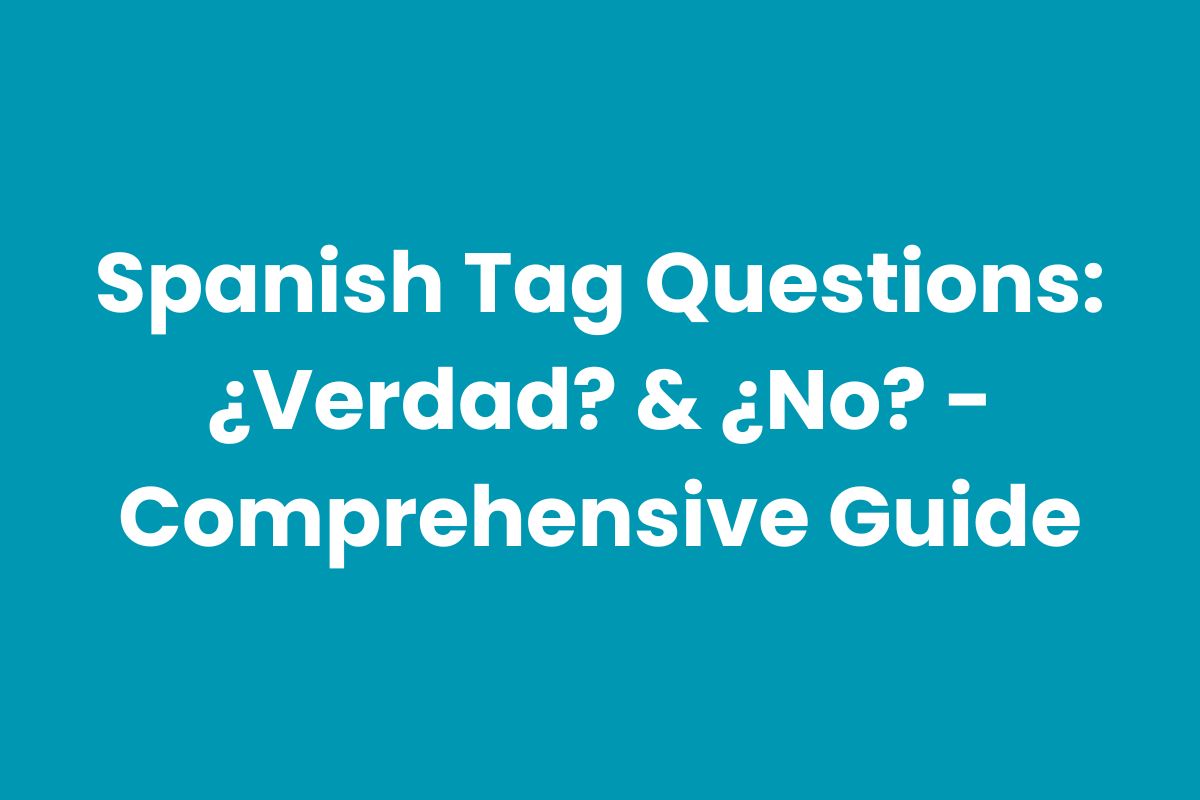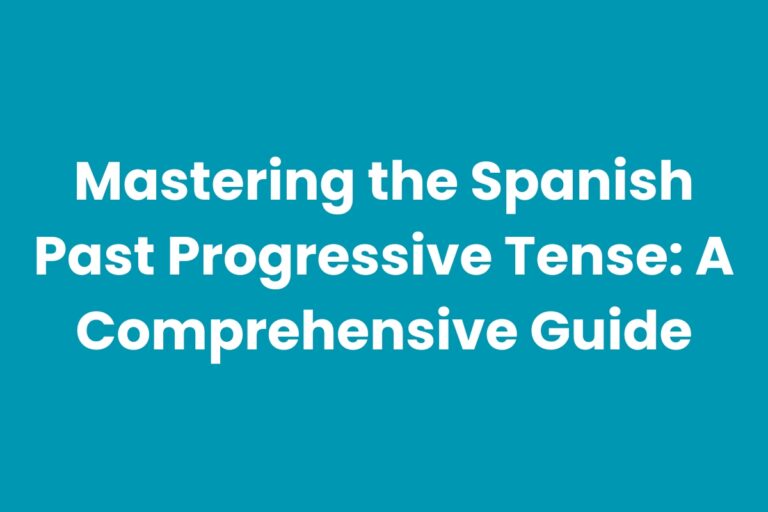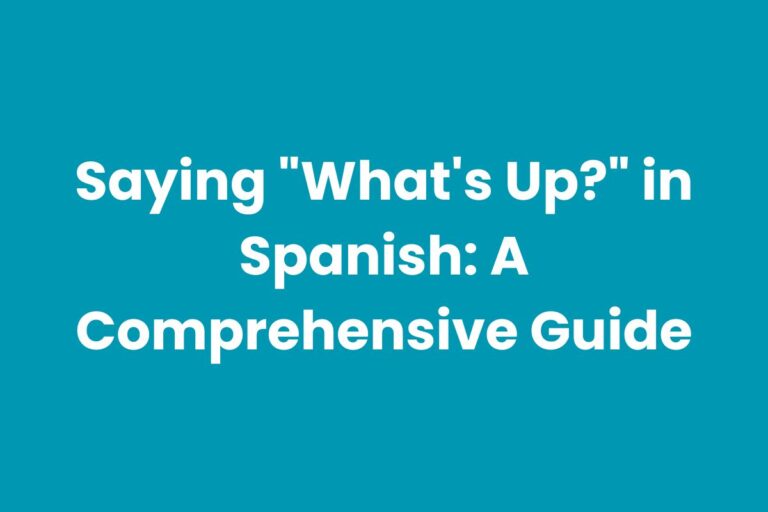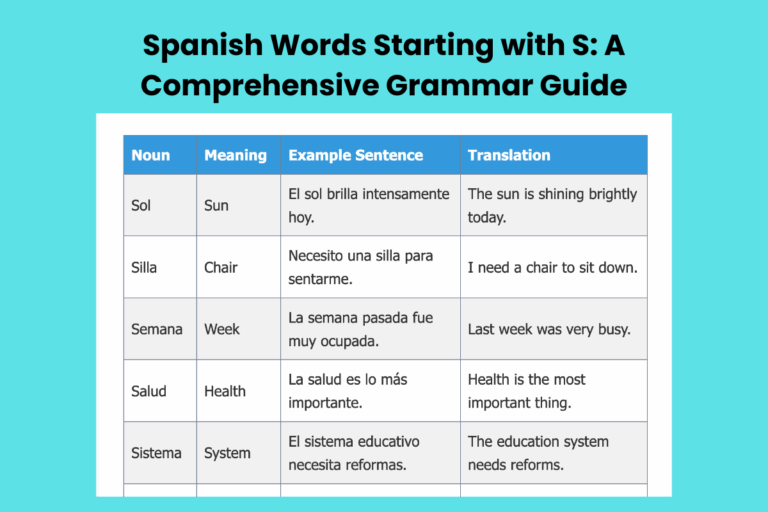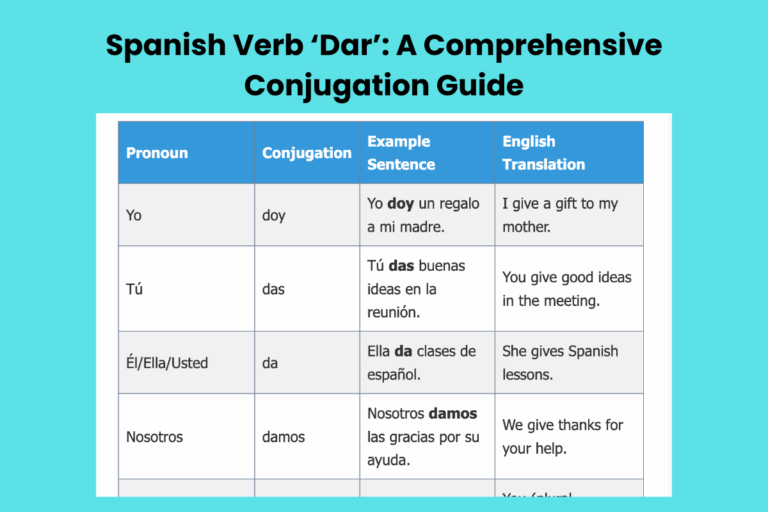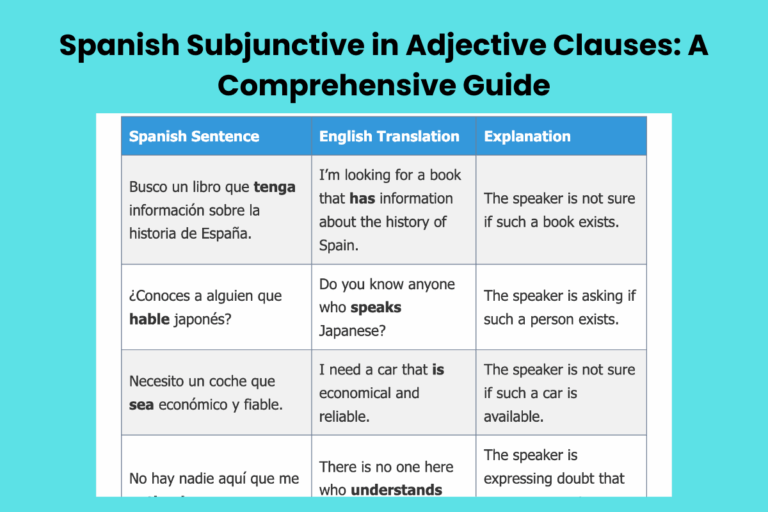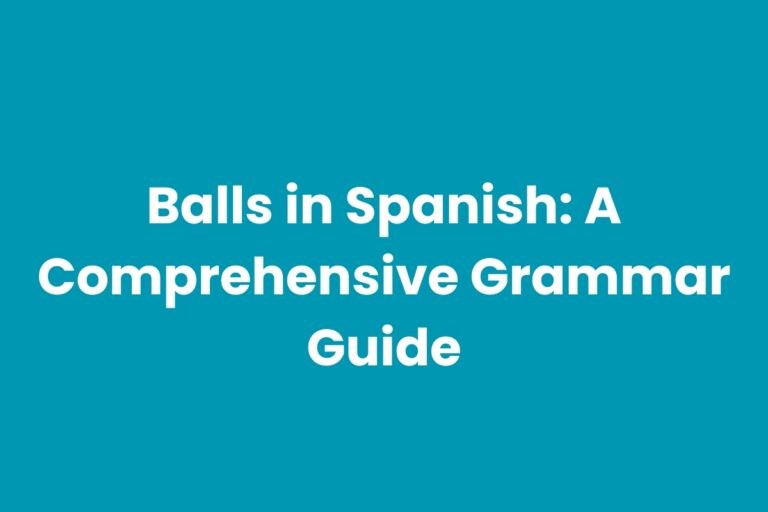Spanish Tag Questions: ¿Verdad? & ¿No? – Comprehensive Guide
Tag questions are a fundamental aspect of conversational Spanish, adding nuance and engagement to everyday interactions. Mastering these short additions to statements, such as ¿verdad? and ¿no?, allows speakers to seek confirmation, express doubt, or simply invite agreement. This guide is designed to provide a comprehensive understanding of Spanish tag questions, exploring their various forms, usage rules, and common pitfalls. Whether you’re a beginner or an advanced learner, this article will equip you with the knowledge and practice needed to confidently use tag questions in your Spanish conversations.
Table of Contents
- Introduction
- Definition of Spanish Tag Questions
- Structural Breakdown
- Types and Categories of Tag Questions
- Examples of Spanish Tag Questions
- Usage Rules
- Common Mistakes
- Practice Exercises
- Advanced Topics
- FAQ
- Conclusion
Definition of Spanish Tag Questions
Tag questions, known as coletillas in Spanish, are short phrases added to the end of a statement to turn it into a question. They serve various purposes, including seeking confirmation, expressing surprise, or simply engaging the listener in a conversation. Unlike English tag questions, which often require auxiliary verbs and pronouns that mirror the statement, Spanish tag questions are typically simpler and more standardized.
The primary function of a tag question is to elicit a response or agreement from the listener. Tag questions can also soften a statement, making it less assertive, or emphasize a point.
The choice of tag question can subtly alter the tone and intention of the speaker.
In Spanish, the most common tag questions are ¿verdad? and ¿no?. These are versatile and can be used in a wide range of situations. However, other options exist, adding further nuance to communication. Understanding the appropriate context for each type of tag question is crucial for effective communication.
Structural Breakdown
The structure of a Spanish tag question is quite straightforward. It generally consists of a statement followed by a comma and then the tag question itself.
There is no need to repeat verbs or pronouns as in English, simplifying the process for learners. The intonation typically rises slightly at the end of the statement and then rises sharply on the tag question, indicating that a response is expected.
The basic pattern is: Statement + , + Tag Question.
For example:
- Hace calor, ¿verdad? (It’s hot, right?)
- Ella es inteligente, ¿no? (She is intelligent, isn’t she?)
The simplicity of this structure makes it relatively easy for Spanish learners to incorporate tag questions into their speech. However, understanding the nuances of when to use each tag question is key to mastering their use.
Types and Categories of Tag Questions
¿Verdad?
¿Verdad? translates to “true?” or “right?” in English. It’s used to seek confirmation or agreement from the listener. It’s a versatile tag question and can be used after both positive and negative statements. It implies that the speaker believes the statement to be true and is looking for validation.
For example:
- Es un buen libro, ¿verdad? (It’s a good book, right?)
- No te gusta el café, ¿verdad? (You don’t like coffee, right?)
The use of ¿verdad? suggests a degree of certainty on the part of the speaker. It invites the listener to confirm what is being said.
¿No?
¿No? translates to “no?” or “isn’t it?” in English. It is also used to seek confirmation or agreement, but it can also express a slight degree of surprise or doubt. It’s commonly used after positive statements and often implies that the speaker expects the listener to agree.
For example:
- Es muy tarde, ¿no? (It’s very late, isn’t it?)
- Te gusta la pizza, ¿no? (You like pizza, don’t you?)
¿No? can also be used after negative statements, but it’s less common and can sometimes sound a bit confrontational. In these cases, ¿verdad? is often a safer and more polite choice.
Other Tag Questions
While ¿verdad? and ¿no? are the most common, other tag questions exist in Spanish, offering more specific nuances. These include:
- ¿eh?: This is a very informal tag question, similar to “eh?” in English. It’s used to seek clarification or confirmation, often when the speaker didn’t quite hear or understand something.
- ¿sí?: This translates to “yes?” and is used to express surprise or disbelief. It can also be used to invite someone to continue speaking.
- ¿o no?: This translates to “or not?” and is used to offer an alternative or to emphasize a point.
- ¿vale?: Primarily used in Spain, this translates to “okay?” or “right?” and is used to seek agreement or confirmation.
These alternative tag questions are less frequently used than ¿verdad? and ¿no?, but understanding them can enhance your comprehension of spoken Spanish and allow you to express yourself more precisely.
Examples of Spanish Tag Questions
Examples with ¿Verdad?
The following table provides a variety of examples using the tag question ¿verdad?. Each example includes the Spanish sentence, its English translation, and a brief explanation of the context.
| Spanish Sentence | English Translation | Context |
|---|---|---|
| Hace frío hoy, ¿verdad? | It’s cold today, right? | Seeking confirmation about the weather. |
| Ella es tu hermana, ¿verdad? | She is your sister, right? | Confirming a relationship. |
| Te gusta el chocolate, ¿verdad? | You like chocolate, right? | Assuming someone likes chocolate. |
| No tienes hambre, ¿verdad? | You’re not hungry, right? | Checking if someone is not hungry. |
| Es una buena película, ¿verdad? | It’s a good movie, right? | Asking for an opinion about a movie. |
| Estás cansado, ¿verdad? | You’re tired, right? | Noticing someone’s fatigue. |
| No quieres ir, ¿verdad? | You don’t want to go, right? | Checking if someone doesn’t want to go. |
| Es importante estudiar, ¿verdad? | It’s important to study, right? | Stating the importance of studying. |
| No es fácil aprender español, ¿verdad? | It’s not easy to learn Spanish, right? | Acknowledging the difficulty of learning Spanish. |
| Tienes que trabajar mañana, ¿verdad? | You have to work tomorrow, right? | Confirming someone’s work schedule. |
| No has visto esta película, ¿verdad? | You haven’t seen this movie, right? | Checking if someone hasn’t seen a movie. |
| Es caro, ¿verdad? | It’s expensive, right? | Commenting on the price of something. |
| No tienes dinero, ¿verdad? | You don’t have money, right? | Checking if someone doesn’t have money. |
| Es tarde, ¿verdad? | It’s late, right? | Noticing the time. |
| No vas a venir, ¿verdad? | You’re not coming, right? | Checking if someone isn’t coming. |
| Es divertido, ¿verdad? | It’s fun, right? | Commenting on how much fun something is. |
| No sabes la respuesta, ¿verdad? | You don’t know the answer, right? | Checking if someone doesn’t know the answer. |
| Es tu cumpleaños, ¿verdad? | It’s your birthday, right? | Confirming someone’s birthday. |
| No estás de acuerdo, ¿verdad? | You don’t agree, right? | Checking if someone doesn’t agree. |
| Es complicado, ¿verdad? | It’s complicated, right? | Commenting on the complexity of something. |
| No te gusta el picante, ¿verdad? | You don’t like spicy food, right? | Checking if someone doesn’t like spicy food. |
| Es un buen restaurante, ¿verdad? | It’s a good restaurant, right? | Asking for an opinion about a restaurant. |
| No tienes tiempo, ¿verdad? | You don’t have time, right? | Checking if someone doesn’t have time. |
| Es fácil, ¿verdad? | It’s easy, right? | Commenting on how easy something is. |
| No quieres salir, ¿verdad? | You don’t want to go out, right? | Checking if someone doesn’t want to go out. |
| Es interesante, ¿verdad? | It’s interesting, right? | Commenting on how interesting something is. |
Examples with ¿No?
The following table provides a variety of examples using the tag question ¿no?. Each example includes the Spanish sentence, its English translation, and a brief explanation of the context.
| Spanish Sentence | English Translation | Context |
|---|---|---|
| Hace calor hoy, ¿no? | It’s hot today, isn’t it? | Seeking agreement about the weather. |
| Ella es tu hermana, ¿no? | She is your sister, isn’t she? | Expecting confirmation of a relationship. |
| Te gusta el chocolate, ¿no? | You like chocolate, don’t you? | Assuming someone likes chocolate and seeking agreement. |
| Es una buena película, ¿no? | It’s a good movie, isn’t it? | Expressing an opinion and seeking agreement. |
| Estás cansado, ¿no? | You’re tired, aren’t you? | Noticing someone’s fatigue and seeking confirmation. |
| Es importante estudiar, ¿no? | It’s important to study, isn’t it? | Emphasizing the importance of studying and seeking agreement. |
| Tienes que trabajar mañana, ¿no? | You have to work tomorrow, don’t you? | Confirming someone’s work schedule and seeking agreement. |
| Es caro, ¿no? | It’s expensive, isn’t it? | Commenting on the price of something and seeking agreement. |
| Es tarde, ¿no? | It’s late, isn’t it? | Noticing the time and seeking agreement. |
| Es divertido, ¿no? | It’s fun, isn’t it? | Commenting on how much fun something is and seeking agreement. |
| Es tu cumpleaños, ¿no? | It’s your birthday, isn’t it? | Confirming someone’s birthday and seeking agreement. |
| Es complicado, ¿no? | It’s complicated, isn’t it? | Commenting on the complexity of something and seeking agreement. |
| Es un buen restaurante, ¿no? | It’s a good restaurant, isn’t it? | Asking for an opinion about a restaurant, expecting agreement. |
| Es fácil, ¿no? | It’s easy, isn’t it? | Commenting on how easy something is and seeking agreement. |
| Es interesante, ¿no? | It’s interesting, isn’t it? | Commenting on how interesting something is and seeking agreement. |
| Vas a venir a la fiesta, ¿no? | You’re coming to the party, aren’t you? | Expecting someone to come to the party. |
| Tienes hermanos, ¿no? | You have siblings, don’t you? | Assuming someone has siblings. |
| Sabes hablar francés, ¿no? | You know how to speak French, don’t you? | Assuming someone knows how to speak French. |
| Trabajas aquí, ¿no? | You work here, don’t you? | Assuming someone works at a certain place. |
| Vives en Madrid, ¿no? | You live in Madrid, don’t you? | Assuming someone lives in Madrid. |
| Estudias medicina, ¿no? | You study medicine, don’t you? | Assuming someone studies medicine. |
| Te gusta el verano, ¿no? | You like summer, don’t you? | Assuming someone likes summer. |
| Conoces a Juan, ¿no? | You know Juan, don’t you? | Assuming someone knows Juan. |
| Has estado en España, ¿no? | You’ve been to Spain, haven’t you? | Assuming someone has been to Spain. |
| Tienes un coche nuevo, ¿no? | You have a new car, don’t you? | Assuming someone has a new car. |
Examples with Other Tag Questions
This table illustrates the use of less common tag questions in Spanish.
| Spanish Sentence | English Translation | Tag Question | Context |
|---|---|---|---|
| No te oigo bien, ¿eh? | I can’t hear you well, eh? | ¿eh? | Seeking clarification because of poor audibility. |
| Ganamos el partido, ¿sí? | We won the game, yes? | ¿sí? | Expressing surprise or seeking confirmation of a victory. |
| Vamos a ir al cine, ¿o no? | We’re going to the cinema, or not? | ¿o no? | Offering an alternative or seeking a decision. |
| Nos vemos mañana, ¿vale? | We’ll see each other tomorrow, okay? | ¿vale? | Seeking agreement or confirmation (primarily in Spain). |
Usage Rules
While Spanish tag questions are generally straightforward, there are some usage rules to keep in mind:
- Intonation: As mentioned earlier, the intonation should rise slightly at the end of the statement and then rise sharply on the tag question. This indicates that a response is expected.
- Context: Choose the tag question that best reflects your intention. If you are genuinely seeking confirmation, ¿verdad? is often a good choice. If you are expressing surprise or doubt, ¿no? might be more appropriate.
- Formality: Some tag questions, like ¿eh?, are very informal and should only be used with people you know well. ¿Verdad? and ¿no? are generally safe in most situations.
- Negative Statements: When using a negative statement, ¿verdad? is often preferred, as ¿no? can sometimes sound confrontational.
Understanding these rules will help you use tag questions effectively and appropriately in your Spanish conversations.
Common Mistakes
One of the most common mistakes is overusing tag questions. While they can be useful, using them too frequently can make you sound unsure of yourself or annoying. Another mistake is using the wrong tag question for the context. For example, using ¿no? after a negative statement when ¿verdad? would be more appropriate.
Here are some examples of common mistakes and how to correct them:
| Incorrect | Correct | Explanation |
|---|---|---|
| No te gusta, ¿no? | No te gusta, ¿verdad? | Using ¿verdad? after a negative statement is more polite. |
| Es muy bueno, ¿verdad? ¿Verdad? ¿Verdad? | Es muy bueno, ¿verdad? | Avoid overusing tag questions. |
| Estoy cansado, ¿eh? (said to a stranger) | Estoy cansado, ¿no? (or no tag question) | ¿Eh? is too informal for use with strangers. |
By being aware of these common mistakes, you can avoid them and use tag questions more effectively.
Practice Exercises
Exercise 1: Choose the Correct Tag
Choose the correct tag question (¿verdad? or ¿no?) to complete each sentence.
| Sentence | Correct Tag |
|---|---|
| Hace sol hoy, ________? | |
| No tienes hermanos, ________? | |
| Es un libro interesante, ________? | |
| Estás contento, ________? | |
| No vas a venir mañana, ________? | |
| Es fácil, ________? | |
| No te gusta el café, ________? | |
| Tienes sueño, ________? | |
| No es caro, ________? | |
| Es tarde, ________? |
Answer Key:
| Sentence | Correct Tag |
|---|---|
| Hace sol hoy, ________? | ¿no? |
| No tienes hermanos, ________? | ¿verdad? |
| Es un libro interesante, ________? | ¿no? |
| Estás contento, ________? | ¿no? |
| No vas a venir mañana, ________? | ¿verdad? |
| Es fácil, ________? | ¿no? |
| No te gusta el café, ________? | ¿verdad? |
| Tienes sueño, ________? | ¿no? |
| No es caro, ________? | ¿verdad? |
| Es tarde, ________? | ¿no? |
Exercise 2: Translate and Add a Tag
Translate the following sentences into Spanish and add an appropriate tag question (¿verdad? or ¿no?).
| English Sentence | Spanish Translation with Tag |
|---|---|
| It’s raining, isn’t it? | |
| You don’t like spicy food, right? | |
| She’s a doctor, isn’t she? | |
| You’re going to the beach, right? | |
| It’s difficult, isn’t it? | |
| You don’t have any pets, right? | |
| He’s your friend, isn’t he? | |
| You’re studying Spanish, right? | |
| It’s cold today, isn’t it? | |
| You don’t work on Sundays, right? |
Answer Key:
| English Sentence | Spanish Translation with Tag |
|---|---|
| It’s raining, isn’t it? | Está lloviendo, ¿no? |
| You don’t like spicy food, right? | No te gusta la comida picante, ¿verdad? |
| She’s a doctor, isn’t she? | Ella es médica, ¿no? |
| You’re going to the beach, right? | Vas a la playa, ¿verdad? |
| It’s difficult, isn’t it? | Es difícil, ¿no? |
| You don’t have any pets, right? | No tienes mascotas, ¿verdad? |
| He’s your friend, isn’t he? | Él es tu amigo, ¿no? |
| You’re studying Spanish, right? | Estás estudiando español, ¿verdad? |
| It’s cold today, isn’t it? | Hace frío hoy, ¿no? |
| You don’t work on Sundays, right? | No trabajas los domingos, ¿verdad? |
Advanced Topics
For advanced learners, consider exploring more subtle uses of tag questions. For example, the tone of voice can significantly alter the meaning of a tag question. A sarcastic tone can turn a simple question into a pointed remark. Also, pay attention to regional variations. While ¿vale? is common in Spain, it’s less frequently used in Latin America. Understanding these nuances will help you communicate more effectively and naturally in Spanish.
Another advanced topic is the use of tag questions in formal writing. While they are primarily a feature of spoken language, they can sometimes be used in informal written communication, such as emails or personal letters, to create a more conversational tone.
However, they should generally be avoided in formal writing.
Lastly, mastering the use of tag questions can also improve your listening comprehension. Native speakers often use them rapidly and subtly, and being able to recognize and interpret them will help you understand the nuances of spoken Spanish.
FAQ
- What is the difference between ¿verdad? and ¿no?
¿Verdad? generally seeks confirmation and is often used after both positive and negative statements. ¿No? also seeks confirmation but can imply a degree of surprise or doubt and is typically used after positive statements.
- Can I use tag questions in formal situations?
Tag questions are generally informal and best suited for casual conversations. Avoid using them in formal writing or presentations.
- Are there regional variations in the use of tag questions?
Yes, some tag questions, like ¿vale?, are more common in certain regions (e.g., Spain) than others.
- How do I know which tag question to use?
Consider your intention. Are you genuinely seeking confirmation, expressing surprise, or simply engaging the listener? Choose the tag question that best reflects your intention.
- Can I use tag questions after negative statements?
Yes, but ¿verdad? is often a safer and more polite choice than ¿no? after a negative statement.
- What happens if I use the wrong tag question?
While it’s unlikely to cause major misunderstandings, using the wrong tag question can make you sound unnatural or less fluent. Pay attention to context and practice using different tag questions to improve your accuracy.
- How can I improve my understanding of tag questions in spoken Spanish?
Listen to native speakers in conversations, movies, and TV shows. Pay attention to how they use tag questions and try to imitate their intonation and usage.
- Are there any other tag questions besides ¿verdad? and ¿no?
Yes, there are other tag questions such as ¿eh?, ¿sí?, ¿o no? and ¿vale?, but these are less commonly used than ¿verdad? and ¿no?. They also have more specific contexts in which they are appropriately used.
- Can I use tag questions to soften a statement?
Yes, tag questions can be used to make a statement less assertive or more polite. For example, saying “Es un poco caro, ¿no?” (It’s a bit expensive, isn’t it?) is less direct than simply saying “Es caro” (It’s expensive).
- How does intonation affect the meaning of a tag question?
Intonation is crucial. Rising intonation indicates a genuine question, while falling intonation can suggest a statement of fact or even sarcasm.
Conclusion
Mastering Spanish tag questions is essential for enhancing your conversational skills and achieving fluency. By understanding the different types of tag questions, their usage rules, and common pitfalls, you can effectively engage in conversations, seek confirmation, and express your opinions with greater nuance.
Remember that practice is key. The more you listen to and use tag questions in real-life situations, the more natural they will become.
Continue to expand your knowledge by exploring advanced topics such as regional variations and the subtle nuances of intonation. With dedication and practice, you’ll be able to use Spanish tag questions confidently and effectively, making your conversations more engaging and natural.
Don’t be afraid to experiment and make mistakes – that’s how you learn and improve!

